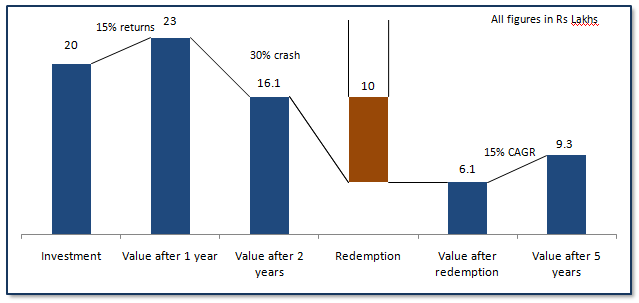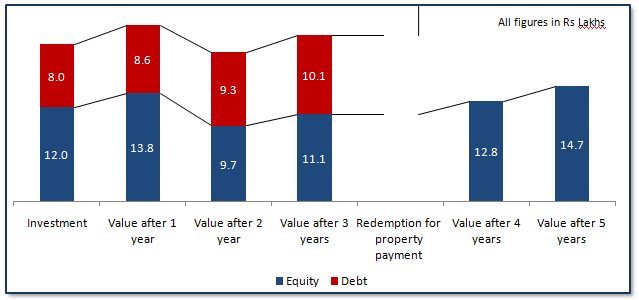What is asset allocation and the importance of it

What is asset allocation?
Asset allocation is the mix of different asset classes in an investment portfolio – the two most common asset classes are fixed income (debt) and equity. Gold and real estate are also popular asset classes in India. Equity is a risky asset class – the main objective of equity investment is capital appreciation or wealth creation. Fixed income or debt is the least risky asset class – the main objective of debt investment is risk reduction and income. Gold is usually riskier than debt. In the long term gold is seen as a hedge against inflation. Gold is also usually counter-cyclical to equity and therefore, can also be a hedge against equity risk. Real estate is as risky as equity but has the lowest liquidity among all asset classes.
Importance of asset allocation
Different investors have different risk appetite and financial needs – asset allocation ensures that the investment portfolio is aligned with the risk appetite and financial needs of the investor. Let us understand this with the help of an example.
Suppose you have Rs 20 lakhs for investment and you need Rs 10 lakh in 3 year time to make the down payment for a property investment.
Scenario 1:-
You invest 100% in equity. You get 15% return in year 1 and then see a 30% crash in year 2, which sees your investment fall in value to Rs 16 lakhs. Since you need minimum Rs 10 lakh for the property investment next year, you cannot take a risk and you will redeem Rs 10 lakh. The balance amount will remain invested in equity. Let us see how much your investment grows to in 5 years, assuming 15% CAGR returns from year 3 onwards.

You can see that your portfolio value after 5 years would be Rs 9.3 lakhs.
Scenario 2:-
Suppose you invested Rs 12 lakhs in equity and Rs 8 lakhs in debt. Let us assume debt gives you 8% annualized return in 3 years. Equity like in scenario 1, gives 15% return in year 1, falls 30% in year 2 and gives 15% CAGR returns from year 3 onwards. Let us see how much your investment grows to in 5 years.
Value after 4 years – 12.9 Lakhs
Value after 5 years is 14.8 Lakhs

Clearly second scenario is better because your investment value at the end of 5 years is almost Rs 5 lakhs higher. Asset allocation provided downside protection to your portfolio from downside market risk and provided liquidity for your medium term requirement (down payment for property purchase), while equity provided you long term capital appreciation.
Determining right asset allocation
Determining the optimal or right asset allocation is one of the most important factors in ensuring success of financial goals. Research indicates that 90% of the portfolio performance can be attributed to asset allocation. Your asset allocation should depend on the following factors:-
- Your long term, medium term and short term goals – all goals are important
- Your risk appetite – age, income, assets and liabilities
- Short to intermediate term liquidity needs
- Liquidity profile of your existing investments
- Life insurance protection
Rule of 100 – a popular Asset Allocation principle
Rule of 100 is a popular asset allocation rule, wherein the proportion (in percentage terms) of equity in your portfolio should be 100 minus you age. So if you are 30 years old, the proportion of equity in your portfolio should be 70%; the balance 30% should be in debt. If you are 50 years old, the proportion of equity in your portfolio should be 50%, the balance 50% in debt. Rule of 100 is a popular asset allocation rule, but by no means the best one in all situations. You should have your own asset allocation depending on the five factors discussed above. Once you determine your asset allocation, you should form an investment plan and stick to it – discipline is of utmost importance in investing
What factors are not important?
Current market conditions:
You should not shift your asset allocation from debt to equity just because market is rallying. By the same token, you should not shift from equity to debt when market crashes. Your target asset allocation should be based on investment goals. Goals do not change with market cycles. We would again reiterate the importance of discipline in managing your investments.Investment experience:
Experienced investors, especially investors who have invested through several market cycles, are able to handle volatility better and take better investment decisions. However, you should not take more risks than warranted just because you are an experienced investor. Lack of experience, at the same time, should not make investors excessively risk averse. Market risk affects all investors – experienced or inexperienced. Experience or lack of it should not bias asset allocation. Mutual funds are great investment options for both inexperienced and experienced investors.Changes in taxation:
The Government, from time to time announces changes in taxes on investment gain / income, but this should not influence your asset allocation. Changes in taxation neither change the risk profile of different asset classes nor your goals. For example, earlier this year, the Government announced 10% tax on long term capital gains in equity mutual funds (long term capital gains was tax free earlier) but that did not deter investors from continuing to invest in equity. You can make changes to your portfolio in response to taxation changes if you are able to find tax friendly products of similar risk profile but you ensure that the risk profile (asset allocation) of your portfolio investment does not change.
Asset Rebalancing
Some asset classes in your investment portfolio will grow faster or slower than other asset classes in different market cycles.Therefore, over a period of time the asset allocation of your investment portfolio will deviate from your target optimal asset allocation – as the deviation grows larger, the risk profile of your investment portfolio will no longer by in sync with your risk appetite and this can harm your long term goals.
Let us understand this with the help of an example –
Let us suppose, you invested Rs 10 lakhs - 60% in equity and 40% in debt assets, as per your target asset allocation. Let us assume that the equity grows at 15% CAGR over the next 4 years, while the debt assets grow at 8% CAGR. After 4 years your total investment value will Rs 15.9 lakhs. What will your asset allocation be after 4 years? It will be 66% equity and 34% debt; in other words, your investment portfolio has become more risky than you had intended it to be in the first place.
Let us suppose in year 5, equity falls by 25%, while debt continues to give 8% returns. Your portfolio value after year 5 will be Rs 13.7 lakhs – a year on year loss of Rs 2.2 lakhs. Now if you rebalanced your portfolio at the end of every year to bring it back to your target 60:40 ratio then your portfolio value after 5 years will be Rs 13.9 lakhs (please see table below).

Asset allocation rebalancing helps investors protect the wealth. You need to consider several factors like exit load, debt and equity taxation etc. when deciding your rebalancing intervals. As per new tax rules announced this year, long term capital gains of up to Rs 1 lakh is tax free. However, this change should not form an incentive to book profits and rebalance every year. You should rebalance when your asset allocation is out of skew with your target asset allocation – you can take advantage of Rs 1 lakh long term capital gains exemption limit when you rebalance.
Conclusion
Most investors in India do not give due importance to asset allocation and this is reason; we often see erratic behavior which harms investors’ interests in the long term. In this blog post, we discussed why asset allocation is a very important factor in financial planning. Further, we discussed various factors that should drive your asset allocation and also factors that are irrelevant but often influence wrong investment decisions. Asset allocation rule of 100 should serve a rough guideline, when you think about asset allocation, but you should consider other factors too discussed in this post. If you are not sure about your optimal asset allocation you can consult with a certified financial planner or with your financial advisor to determine your optimal asset allocation. Finally, asset rebalancing is important in ensuring that the risk profile of your portfolio is aligned with your risk capacity.
Mutual Fund Investments are subject to market risk, read all scheme related documents carefully.
#Wise With Edelweiss – An Investor Education Initiative by Edelweiss Mutual Fund.
EAML is amongst the fastest growing asset management companies, being an asset management subsidiary of Edelweiss Financial Services Ltd., one of Indias leading financial services group since last 21 years with a proven track record of quality and innovation. Edelweiss AML is present across 11 locations across the country. EAML offers a suite of differentiated asset management products and the unique knowledge proposition focusing on building a strong connect with Distributors and customers. At Edelweiss AMC, the aim is to come up with truly innovative ideas that doesnt exist today and bridge the gap between what investors want and what the industry has to offer.
Quick Links
Contact Us
- Toll Free : 1800 425 0090
- Non Toll Free : +91-40-23001181
- EMFHelp@edelweissfin.com
- distributor.amc@edelweissfin.com
POST A QUERY





